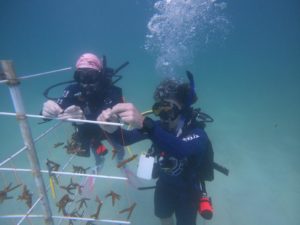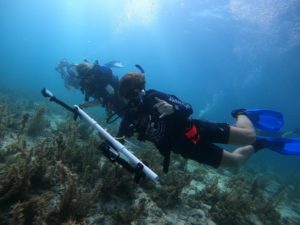Walking around on the seafloor like a freshly minted astronaut. The bubbles from my regulator reminiscent of a peaceful fountain in a meditation room.

Gabe and Sierra hang newly cut coral fragments in the Mote coral nursery. They will later be outplanted to a local reef.
Coming eye to eye with a hogfish as I fragmented and hung corals- both of us in awe of one another. All these unbelievably unique experiences gifted to us on our trip to the Florida Keys over a weekend in September.
The ocean is beneficial to all, but understood by few. It is withering away at an incomprehensible rate, and without these missions by the future scientists of the world, I may not have the same hope as I do. On Day 1 and Day 2 of our trip, we worked with MOTE in their state-of-the-art coral nursery fragging (taking cuttings), and out-planting coral. The first step keeps new corals growing in the nursery. The second step involves transplanting the new growth to the live reef. They are cultivating several different genotypes, or genetic varieties, to restore the reefs, and research their resilience against the many threats the ocean faces. With our help, MOTE systematically expands the nursery to lots of new manmade trees, fragging, stringing with monofilament line, and hanging up 500 pieces of coral, similar to decorating a Christmas tree with the most meaningful ornaments.
New Technology to Map the Reef

Gabe and his dive buddy take a pause from collecting photos that will be used to make a composite mosaic map of the reef to pose for the camera.
On Day 3, we start our photomosaic project by descending down on the reef looking for the best section to map. Then we select the perimeter of the 10 by 10 meter section of the reef we will photograph. Next comes the most important and most difficult task – mapping the reef – which requires me to swim in the pattern of a grid until I have passed over every piece of coral at least twice. The result will paint a picture no one pair of eyes can see once we use software to stich hundreds of photos together into one image.
Fish and benthic (bottom) surveys were also an important part of our research that day conducted by my fellow nauts and our new friends from another youth diving group, DiveN2Life. With this research, we document for all to see the dire conditions of the ecosystem. Below me, coral calmly crackling like a tranquil campfire. Fish freely finning weightless above a protected reef. The ocean should be seen and understood by everyone. Because of SCUBAnauts, we are one step closer to that reality.
Gabe M., Naut-in-Training, Sarasota Chapter

